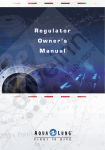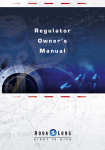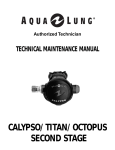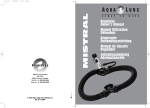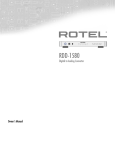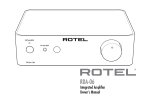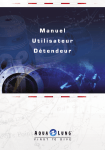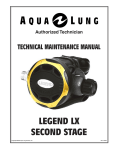Download Aqua Lung LEGEND Owner`s manual
Transcript
Regulator OwnerÊs Manual Regulator OwnerÊs Manual Copyright This owner’s manual is protected by the law of 11 March 1957 concerning literary and artistic property. It may not, in whole or part, be copied, photocopied, reproduced, without prior consent in writing from Aqua Lung. © 2007 Aqua Lung International, Inc. Regulator Owner’s Manual, P/N 127861 rev. 10/07 Danger, warnings and Notes A certain number of icons have been used in order to make this User Manual easier to understand. They have the following meanings : DANGER indicates situations of risk or danger that could cause serious accidents or death if these indications are not followed correctly. WARNING indicates features or special situations in diving and aims to avoid risk situations. A NOTE is used to indicate information that will allow you to enjoy the best use of your regulator. 2 Summary (to reach directly a chapter, click on the title) 1 GENERAL PRECAUTION & WARNINGS 1.2 ENRICHED AIR NITROX USE 1.2.1 Enriched Air Nitrox Use 2. Introduction 2.1 CE Conformity 2.2 Features 2.3 VANE ADJUSTMENT SWITCH (VAS) 2.4 Valve Adjustment Knob (VAK) 2.4.1 LEGEND LX Regulator 2.4.2 Kronos Second Stage Adjustment: “Dual Cam”. 2.4.3 MIKRON Regulator 2.5 First Stage Environmental Protection series Titan, Kronos, Legend “supreme” 2.6 Registered patents 3. PREPARATION AND SET UP 3.1 Mounting the First Stage Onto the Cylinder Valve 3.1.1 Yoke Connector 3.1.2 DIN Connector 3.2 Pre-Dive Checks 3.3 Pressurising the regulator 3.4 Divisible mouthpiece 4. DIVING WITH THE REGULATOR 4.1. COLD WATER DIVING 5. AFTER THE DIVE 5.1 Removal of the Regulator from the Cylinder Valve 5.1.1 General Procedures 5.1.2 Yoke Connector 5.1.3 DIN Connector 5.2 Cleaning 6. USER CARE & MAINTENANCE 7. DEALER INSPECTION & SERVICE 8. WARRANTY INFORMATION 8.1 USA only 8.1.1 The Aqua Lung Satisfaction Guarantee™ 8.1.2 The Aqua Lung Limited Lifetime Warranty 8.2.1 The Aqua Lung warranty 10. Returning Your Regulator For Service 11. Contacting Aqua Lung AMERICA via Electronic Mail 12. ANNUAL INSPECTION & SERVICE RECORD 3 1 GENERAL PRECAUTION & WARNINGS • Before using this regulator, you must have successfully received training and certification in the technique of SCUBA diving from a recognized certification agency. Use of SCUBA equipment by uncertified, or untrained persons, is dangerous and can result in serious injury, or death. • This regulator is not configured for commercial use with surface supplied air. • Always pressurize the regulator gradually by opening the cylinder valve SLOWLY. • NEVER lubricate any part of the regulator (particularly the O-ring providing the seal between the cylinder valve and the regulator) with any lubricant. • DO NOT apply any type of aerosol spray on the regulator. Doing so may cause permanent damage to certain plastic components. • The user should not undertake any assembly, disassembly or adjustment other than those prescribed. • Factory prescribed service for this regulator must be performed at least once annually by a factory trained Aqua Lung Service Technician who is employed by an Authorized Aqua Lung Dealer. • DO NOT use the regulator first stage as a carrying handle when lifting or transporting the cylinder as this can damage the regulator or the cylinder valve. • When diving in cold water (below 50°F, or 10°C), you must have received training and certification in the techniques of cold water diving from a recognized training agency. • If you are using a first stage in the Legend series or a Kronos Supreme, you are recommended to use an pneumatically balanced Octopus (LX Octopus, Legend Octopus, Kronos Octopus, Mikron Octopus) to avoid the possibility of a free flow at depth. 4 Back to the contents 1.2 ENRICHED AIR NITROX USE DANGER : This chapter contains important information concerning use with oxygen-enriched air (Nitrox/EAN). Do not attempt to use this product with enriched air without having entirely read and understood this chapter. If you do not do this, you risk serious accident or death. DANGER : Obtain Nitrox Diving Certification In order to gain a complete appreciation of the advantages of diving with Nitrox, it is ABSOLUTELY NECESSARY that you undergo special training and obtain certification in Nitrox diving from a recognised training agency. The depth and time limit of the dive depend on the oxygen content of the Nitrox mixture. 5 Back to the contents 1.2.1 Enriched Air Nitrox Use Your Aqua Lung regulator has been prepared for use with Enriched Air Nitrox (EAN) where the percentage of oxygen in the EAN does not exceed 40%. This is possible because each regulator is built to a high standard of cleanliness using EAN compatible components and lubricants. In addition, each regulator design has passed stringent adiabatic compression testing to ensure its safety and compatibility with increased percentages of oxygen. If it is your intention to use your new Aqua Lung regulator with Nitrox EAN (O2 not to exceed 40%), it is imperative that you maintain the internal cleanliness of the regulator (see section on Care and Maintenance). If it is your intent to use the regulator interchangeably with breathing air, the breathing air should be oxygen-compatible or “hyperfiltered” whereas the condensed hydrocarbons do not exceed 0.1 mg/m3. Your local authorized Aqua Lung dealer can help you determine whether the breathing air that they provide meets this criterion. Standard compressed breathing air meeting the EN 12021 standard, often referred to as Grade E in the United States, does not necessarily meet this criterion. Grade E or EN 12021 breathing air may contain a certain level of hydrocarbons, including traces of compressor oils that while not considered harmful to breathe, can pose a risk in the presence of elevated oxygen content. Passing hydrocarbons through a valve and regulator creates a cumulative effect where the hydrocarbons build up over time along the internal passageways of the equipment. When these hydrocarbons come in contact with high-pressure oxygen enriched air, they can pose a very real hazard that can lead to combustion. Therefore, if a regulator has had use with Grade E or EN 12021 breathing air, it should be returned to an authorized Aqualung dealer for overhaul service including hydrocarbon cleaning, prior to being put back into nitrox service. Although second stage components are not exposed to high pressure EAN, Aqua Lung recommends that the same cleaning procedures be followed for the complete regulator. This prevents the possibility of cross contamination and guarantees the cleanliness of the entire regulator. 6 Back to the contents 2. INTRODUCTION Congratulations – and thank you – for choosing Aqua Lung. Your new regulator meets all existing standards for quality and performance and has been designed and manufactured with the greatest care. Perhaps, more than any other item of equipment that you have bought, the better care you take of your regulator, the better it will perform for you. Its performance will be guaranteed by regular servicing at an appointed Aqua Lung Service Centre. Before diving with your new Aqua Lung regulator it is important that you read this manual in its entirety so that you can familiarise yourself with its features and the rules for using the regulator before, during and after the dive so as to retain optimum performance for the years to come. 2.1 CE Conformity This regulator has successfully passed all the tests required by the EN 250:2000 standard and has received certification for this type. The maximum operating depth limit required by the standard for certifying the equipment is 50 metres. If your regulator carries the >10°C mark, this indicates that the regulator is not intended for use in water at a temperature below 10°C. This mark can be found on the 1st stage body for Titan and Kronos series regulators, or on the 2nd stage for regulators in the Titan LX, Legend series and Mikron. See photos. 7 Back to the contents 2.2 Features Calypso Titan / Mikron Kronos / Legend First stage technolgy Piston regulator Diaphragm regulator Diaphragm regulator Maximum working pressure Yoke : 232 bar USA : 3300 PSI DIN : N/A Yoke : 232 bar USA : 3300 PSI DIN : 300 bar Yoke : 232 bar USA : 3300 PSI DIN : 300 bar Number of ports 1 HP 7/16, 4 MP 3/8 1HP 7/16, 4 MP 3/8 2 HP 7/16 , 4 MP 3/8 Hose length 730 MM 730 MM 730 MM 2.3 VANE ADJUSTMENT SWITCH (VAS) Calypso /Titan Kronos Titan LX/Legend Legend LX Most of our second stages are fitted with a Vane Adjustment Switch (VAS). The VAS can be found in one of two different locations depending upon which model you have. It can be located on the side opposite the hose connection OR it can be found on top in front of the mouthpiece. It helps to maintain a high flow of air once you have started to take a breath. When the VAS is set to the “MAX” (or “+”) position, the regulator will provide maximum venturi assistance. When the VAS is set to the “MIN” (or “-”) position, breathing resistance is increased. You should put it on the “MIN” (or “-”) position whenever the regulator second stage is out of your mouth. You may put it on the “MAX” (or “+”) position whenever the mouthpiece is in your mouth. 8 Back to the contents 2.4 Valve Adjustment Knob (VAK) 2.4.1 LEGEND LX Regulator The VAK, located opposite of the hose connection on certain model second stages, adjusts the effort required to start the air flow at the beginning of the inhalation cycle. As it is turned “in” (clockwise), the opening effort will increase. This will make the second stage less sensitive to sudden changes in ambient pressure. Turning the knob “out” (counter-clockwise) will decrease the opening effort to make breathing easier. This adjustment is particularly useful at deeper depths, or in variable conditions that affect the opening effort of the second stage, such as strong currents or while using a diver propulsion vehicle (DPV). It will also allow compensation for a difference in the hydrostatic pressure and the centre of your lungs, such as when you are in a head-down position. You can use the VAK to tune your regulator to maintain its peak performance throughout the course of your dive, or you can leave it set in its mid-range position and dive with as you would any nonadjustable second stage. 2.4.2. Kronos Second Stage Adjustment: „Dual Cam‰. The Dual Cam patented adjustment system combines both the VAS and the VAK. In the “+” position: the VAS is maximum and the VAK is minimum (turned out). This gives optimum performance (average: 1.2j/l according EN 250). In the “-“ position: the VAS is minimum and the VAK is maximum (turned in). This reduces performance to the maximum allowed by EN 250 (average: 2.8j/l). This offers a very effective pre-dive position. 2.4.3 Mikron Regulator The VAK, located opposite of the hose connection on certain model second stages, adjusts the effort required to start the air flow at the beginning of the inhalation cycle. As it is turned “in” (clockwise), the opening effort will increase. This will make the second stage less sensitive to sudden changes in ambient pressure. Turning the knob “out” (counter-clockwise) will decrease the opening effort to make breathing easier. This adjustment is particularly useful at deeper depths, or in variable conditions that affect the opening effort of the second stage, such as strong currents or 9 Back to the contents while using a diver propulsion vehicle (DPV). It will also allow compensation for a difference in the hydrostatic pressure and the centre of your lungs, such as when you are in a head-down position. You can use the VAK to tune your regulator to maintain its peak performance throughout the course of your dive, or you can leave it set in its mid-range position and dive with as you would any nonadjustable second stage. When the VAK is completely unscrewed (counter-clockwise), the regulator will provide maximum performances. When the VAK is completely screwed (clockwise), breathing resistance is increased. NOTE: Since the Mikron does not have a VAS, it is necessary to screw the VAK all the way in when it is out of your mouth. Failure to do so could result in a freeflow situation should the regulator get bumped or the purge cover depressed. 2.5 First Stage Environmental Protection series Titan, Kronos, Legend „supreme‰ For diving in cold-water conditions, or commercial diving in contaminated water, Aqua Lung offers an environmental first stage protection feature that seals the ambient chamber from the environment. This helps to prevent ice from forming and keeps contamination out of the main spring chamber. 2.6 Registered patents : Comfobite mouthpiece: U.S. Patent : 4,862,903 Balanced HP seat: U.S. Patent: 5,746,198 Second stage thermal exchanger: U .S. Patent: 5,265,596 Combined second stage adjustment for Kronos: patent applied for. 10 Back to the contents 3. PREPARATION AND SET UP Aqua Lung America, Inc. recommends that you bring your regulator to your Authorized Aqua Lung Dealer for the installation of any accessory items, including instrumentation, LP quick disconnect hoses, and alternate air sources. DANGER : Whatever the connector, when pressurizing your scuba system, be sure to open the cylinder valve slowly to minimize the generation of heat. Failure to do so, with enriched air nitrox (EAN) present, increases the risk of combustion that can lead to serious injury or death. WARNING : It is considered a safe practice, especially when using EAN, to open the cylinder valve slowly and let the first stage pressurize slowly. Rapid pressurization causes adiabatic compression of the breathing gas, which generates heat inside the first stage. Heat, along with elevated percentages of oxygen and an ignition source (from contamination) are the ingredients that can cause combustion. This is why it is necessary to keep the interior of the regulator clean and the fraction of oxygen below 40% along with the slow opening of the valve. 11 Back to the contents 3.1 Mounting the First Stage Onto the Cylinder Valve 3.1.1 Yoke Connector Partially loosen the yoke screw of the first stage regulator so that the dust cap can be removed from the filter and air inlet. With the cylinder valve facing away from you, release a small amount of air from the cylinder by turning the handwheel counter-clockwise to open the valve only slightly. When air is heard exiting, immediately close the valve. This will clear any moisture or debris that may be inside the cylinder valve outlet opening. Check the condition of the cylinder valve O-ring Place the first stage regulator over the cylinder valve so that the inlet fitting aligns with the O-ring of the cylinder valve, and the LP hose of the primary second-stage will be routed over the right shoulder. While holding the first stage in place, turn the yoke screw clockwise. Ensure that the yoke screw mates into the small dimple on the backside of the cylinder valve, and tighten finger-tight only. 3.1.2 DIN Connector Remove the protector cap from the cylinder valve. With the cylinder valve facing away from you, release a small amount of air from the cylinder by turning the handwheel counter-clockwise to open the valve slightly. When air is heard exiting, immediately close the valve. This will clear any moisture or debris that may be inside the threaded cylinder valve opening. Check the condition of the cylinder valve O-ring. Position the first stage near the cylinder valve so that the LP hose of the primary second-stage will be routed over the right shoulder. Thread the first stage DIN connector into the cylinder valve and turn the handwheel clockwise by hand until it is lightly snug. DO NOT use tools to tighten. 12 Back to the contents 3.2 Pre-Dive Checks 1. Carefully inspect all hoses at their fittings to ensure they are securely connected into their respective ports on the first stage. Inspect the length of each hose to ensure that the hoses are not blistered, cut, or otherwise damaged. If hose protectors are present, slide the protectors back to expose the hose fittings, and inspect the hoses as described above. 2. Visually inspect both the first and second stage regulators for any signs of external damage. 3. Visually inspect the mouthpiece to ensure that there are no tears or splits. 4. Check that the needle of your submersible pressure gauge is on zero. 5. Check that your VAS or Dual Cam is set to “-“. For the Mikron Regulator, check that your VAK is screwed (see chapter 2.4.3). 6. Fit your regulator to the cylinder (see Chapter 3.1), checking that the hoses are oriented correctly. 13 Back to the contents 3.3 Pressurising the regulator CAUTION : Before pressurizing the regulator check the condition of the hoses fitted to the regulator. 1. If a submersible pressure gauge is fitted check that its dial faces away from you. 2. SLOWLY open the cylinder valve to pressurize the regulator. When the valve is completely open, screw it back a quarter turn. 3. Check that there are no leaks from any of the hoses or from any other accessories fitted. NEVER DIVE with a regulator that shows any leaks when placed under pressure. If there is a leak between the regulator and the cylinder check that the regulator is correctly fitted and that the O-ring is in good condition. WARNING : Never attempt to reposition the hoses once the regulator is under pressure. If they are not correctly oriented, Close the cylinder valve, purge the regulator and reposition them. 4. Check to ensure that the submersible pressure gauge is displaying an accurate measurement of the air pressure inside the cylinder at the time of charging and is appropriate for your planned dive. 5. Depress the purge button momentarily to ensure that sufficient airflow is provided to blow out any dust or debris which may have entered the second-stage. 6. Put the regulator in your mouth and place the VAS in “+” position. , for the Mikron Regulator, unscrewed completely the VAK (counter-clockwise). 7. Inhale slowly and deeply from the regulator several times. The regulator must deliver enough air for you to breathe easily without noticeable resistance. 14 Back to the contents 3.4 - Divisible mouthpiece The Mikron for the lady is equipped with a specific mouthpiece. It will perfectly fit the small jaw. The silicone bridge is in contact with the roof of the mouth, if it is uncomfortable you have the opportunity to cut this bridge. Using a pair of scissors or a cutter you can cut the bridge. Just cut where the furrow lines are. 15 Back to the contents 4. DIVING WITH THE REGULATOR If the regulator is used as an alternative air source, it is recommended that you fit a mouthpiece cover to prevent the entry of any foreign bodies while the VAS is in “-“ position. , for the Mikron Regulator, screwed completely the VAK (clockwise). While underwater the regulator may commence to free-flow. If this happens turn the regulator so that the mouthpiece points downward. When you place the regulator in your mouth put the VAS in position “+” to obtain maximum breathing comfort. For the Mikron Regulator, unscrewed completely the VAK (counter-clockwise). 4.1. COLD WATER DIVING : In order to reduce the risks of regulator freezing when diving in cold water (below 50°F or 10°C), consider at least the following recommendations and respect your dive training program procedure : 1. Protect your regulator from any accidental entrance of water into the first or second stages. 2. Protect your equipment from cold before the dive. More precisely, keep your regulator and all its accessories in a warm dry place. 3. Carry out all pre-dive checks of your equipment in a warm dry place, before even going to the dive site. 4. Avoid breathing through the regulator or pressing the purge button in very cold air before entering the water. 5. Avoid removing the regulator from your mouth during the dive, or when on the surface. This will prevent cold water from entering the regulator second stage. 6. As far as is possible, avoid excessive effort during the dive. 7. Have your dive store check that the air in your cylinder meets EN 12021 and is is dry. 16 Back to the contents 5. AFTER THE DIVE 5.1 Removal of the Regulator from the Cylinder Valve NOTE : If fresh water is available, rinse your regulator completely before depressurizing it. This will help to prevent any contaminants from entering sealing surfaces inside the regulator. NOTE : When you remove the regulator from the cylinder take care to prevent the entry of water into the regulator, particularly via the filter. 5.1.1 General Procedures 1. Shut off the cylinder air supply by turning the cylinder valve handwheel clockwise until it stops. 2. While observing the submersible pressure gauge, depress the purge button of the second-stage. When the gauge reads zero and airflow can no longer be heard from the second stage, release the purge button. 5.1.2 Yoke Connector 1. Turn the yoke screw counter-clockwise to loosen and remove the first stage from the cylinder valve. 2. Dry the dust cap with a towel or other lint-free cloth. While you may use air from your tank valve to blow the water off the dust cap, you run the risk of blowing water into the filter. 3. Place the dust cap over the first stage inlet fitting and seal it securely in place by tightening down the yoke screw. 5.1.3 DIN Connector 1. Turn the DIN handwheel counter-clockwise to loosen and remove the first stage fro the cylinder. 2. With the cylinder valve facing away from you, open the valve slightly to release a short burst of air, and then immediately close the valve. This will clear any moisture that may have entered the valve opening. Immediately seal the protector cap securely in place over the opening of the DIN valve to prevent the entrance of moisture or debris. 5.2 Cleaning Aqua Lung recommend disinfecting the regulator second stage with a 2% solution of glutaraldehyde produced by the Anios company (Sterianos, Aqua Lung reference 382062) following the procedure described on the package. 17 Back to the contents 6. USER CARE & MAINTENANCE It is important to provide the proper preventative maintenance in order to ensure the best possible performance and maximum life of your Aqua Lung Regulator. The following maintenance procedures should be performed routinely after each use to ensure that the regulator is cleaned, inspected, and prepared for the next use or for storage. As soon as possible after diving, the regulator should be rinsed thoroughly with fresh water while it is attached to a cylinder and pressurized with air. Rinsing alone, however, will not sufficiently clean the regulator. To clean the regulator as thoroughly as possible Aqua Lung recommends: . Attach the regulator to a charged SCUBA cylinder, open the cylinder valve to pressurize the regulator, and thoroughly soak both the first and second-stages in a bath of fresh water. . While the regulator is soaking, move the vane adjustment switch on the second stage (if present) back and forth several times from the “MIN” (or “—”) to the “MAX” (or “+”) settings. You may also turn the valve adjustment knob (adjustable models) slightly back and forth—no more than 1/4 turn. After the regulator has been properly soaked, it is important to rinse it vigorously by flushing the mainspring cavity of the first stage regulator (non-environmentally sealed models only), the second-stage mouthpiece, and the openings in the second-stage front cover with a pressurized stream of water. This will remove the deposits of salt and minerals that were loosened during soaking. DANGER : if you use a garden hose, do not use the high pressure jet as this could damage the diaphragm and the internal valve. WARNING : DO NOT depress the purge button, loosen the first stage yoke screw, or turn the second stage adjustment knob all the way “out” (adjustable models) if the regulator is submerged unpressurized. Doing so will allow the entrance of moisture, and will require that the regulator be returned to an Authorized Aqua Lung Dealer for service. 18 Back to the contents • Disconnect the regulator and wipe itr as dry as possible and then hang it by the first stage to ensure that all remaining moisture drains from the second stages. • Do not leave the regulator exposed to direct sunlight for long periods. • When the regulator is completely dry, store in a clean equipment box, or sealed inside a plastic bag. Do not store it where it may be exposed to extreme heat or an electric motor, which produces ozone. Prolonged exposure to extreme heat, ozone, chlorine, and ultraviolet rays can cause premature degradation of rubber parts and components. • Never store the regulator while it is still connected to the cylinder valve. DANGER : Do not use any type of solvent or petroleum based substances to clean or lubricate any part of the regulator. Do not expose any part of the regulator to aerosol spray, as some aerosol propellants attack or degrade rubber and plastic materials. 19 Back to the contents 7. DEALER INSPECTION & SERVICE It cannot be assumed that a regulator is in good working order on the basis that it has received little use since it was last serviced. Remember that prolonged or improper storage can still result in internal corrosion and/or deterioration of O-ring seals. You must obtain factory prescribed service for your regulator at least once a year from an Authorized Aqua Lung Dealer, regardless of the amount of use it has received. Your regulator may require this service more frequently, depending on the amount of use it receives and the environmental conditions in which it is used. If the regulator is used for rental or training purposes, it will require complete overhaul and factory prescribed service every three to six months. Chlorinated swimming pool water is an especially damaging environment for SCUBA equipment, due to the high levels of chlorine and pH balancing chemicals that cause certain components to rapidly deteriorate. Obtain service for your regulator at least once a year, from an Authorized Aqua Lung dealer. Your personal safety and the mechanical integrity of your regulator may depend on it. 20 Back to the contents 8. WARRANTY INFORMATION 8.1 USA only All warranty transactions must be accompanied by proof of original purchase from an Authorized Aqua Lung Dealer. Be sure to save your sales receipt, and present it whenever returning your regulator for warranty service. 8.1.1 The Aqua Lung Satisfaction Guarantee™ If any Aqua Lung product that you have purchased from an Authorized Aqua Lung Dealer fails to meet your expectations, Aqua Lung America, Inc. will replace or exchange the product free of charge within thirty (30) days of the original purchase. Exchanges will be made through the same Authorized Dealer for Aqua Lung America, Inc., for merchandise of equal or lesser value, and will be made only for Aqua Lung equipment. Aqua Lung America, Inc. makes this guarantee of satisfaction a part of all product warranties because of the confidence we have in our products. 8.1.2 The Aqua Lung Limited Lifetime Warranty Aqua Lung America, Inc. warrants to the original purchaser that the product will remain free from defects in material and workmanship throughout its useful life; provided that it recieves normal use, proper care and prescribed dealer service subject to those restrictions stated below. This limited warranty is extended only to the original purchaser for purchases made from an Authorized Aqua Lung Dealer, and is not transferable. This warranty is limited to repair or replacement only at the discretion of Aqua Lung America, Inc. WARNING : It may be dangerous for untrained and uncertified persons to use the equipment covered by this warranty. Use of SCUBA equipment by anyone who is not a trained or certified diver, or is not currently receiving training through a recognized certification agency, may lead to serious injury or death. This warranty gives you specific legal rights. You may have rights that vary from state to state and country to country. AQUA LUNG AMERICA, INC. DISCLAIMS AND EXCLUDES ANY LIABILITY FOR INCIDENTAL OR CONSEQUENTIAL DAMAGES Some states in the U.S. and certain foreign countries do not allow exclusions or limitations of liability for incidental or consequential damages, so this may not apply to you. 21 Back to the contents Restrictions The following restrictions apply to this warranty: 1. This warranty does not cover normal wear. Factory prescribed service by an Authorized Aqua Lung Dealer is required at least once annually. 2. This warranty does not extend to damages caused by improper use, improper maintenance, neglect, unauthorized repairs, modifications, accidents, fire, or casualty. 3. Cosmetic damage, such as scratches, dents, and nicks are not covered by this warranty. 4. This warranty does not extend to equipment used for rental, commercial, or military purposes. 5. This warranty covers products purchased in the United States. For warranties that may apply elsewhere, please contact your local representative. 6. Failure to meet any of the above requirements will render the warranty null and void. 22 Back to the contents 10. Returning Your Regulator For Service Whenever your regulator requires annual service or warranty repair, Aqua Lung requires that you bring it or send it to your nearest Authorized Aqua Lung Dealer. If you need to return products covered by this warranty, please provide your dealer with photocopies of your original sales receipt, your Annual Inspection & Service Record and receipt from your last annual service if the product is more than one year old. NOTE: Aqua Lung America, Inc. reserves the right to substantiate the validity of the claim. 11. Contacting Aqua Lung AMERICA via Electronic Mail You can contact Aqua Lung by visiting our website at: www.aqualung.com 23 Back to the contents 12. ANNUAL INSPECTION & SERVICE RECORD Date 24 Dealer Name Technician Name Back to the contents Observations Stamp IMPORTANT NOTICE ABOUT MAIL ORDER SALES OF AQUA LUNG AMERICA PRODUCTS Beware of any retailer that offers to sell and ship our life support products by mail, for orders placed by phone or the internet. These retailers are NOT Authorized Aqua Lung America dealers. All Authorized Aqua Lung America Dealers must execute a Dealer Agreement that does not allow the sale of Aqua Lung America products except «in store». Many Aqua Lung dealers advertise on the internet, but they are not allowed to deliver our products other than «over-the counter». This is our assurance that you will receive the proper presale, point of sale, and post-sale assistance. If you obtain our product from one of these unauthorized retailers, your warranty is not valid and we cannot offer you the assurances of quality and satisfaction afforded by the Aqua Lung America Warranty program. If you would like to verify whether or not a retailer is an Authorized Aqua Lung America Dealer, please call or write to Aqua Lung America, Inc. using the address or phone number provided on the rear cover of this manual. Or, you can visit our website at: www.aqualung.com 25 Back to the contents

























